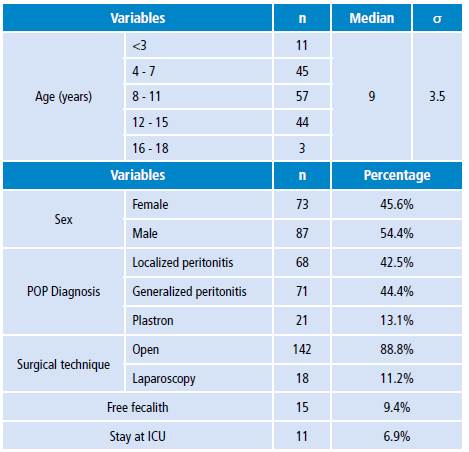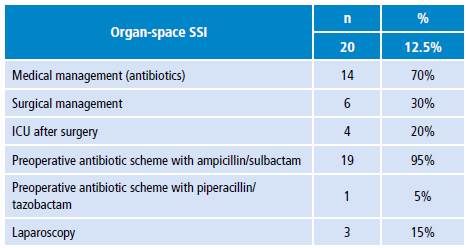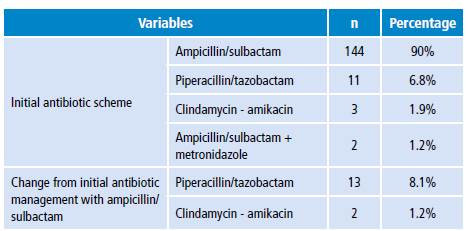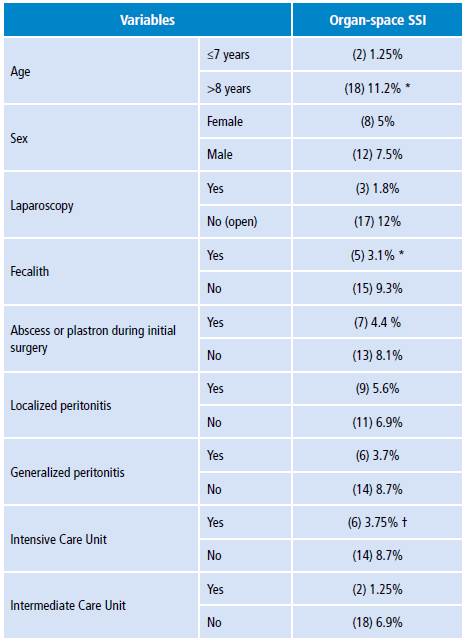Introduction
Surgical site infection (SSI) is defined as an infection that occurs within 30 days after a surgical procedure, or up to one year when an implant has been placed at the surgical site 1,2; it is classified according to its location in superficial, deep and organ-space (OS). SSI is an important cause of morbidity and mortality, post-operative hospital readmission, intensive care unit (ICU) stay, and increased length of hospital stay 3; it represents about 38% of all nosocomial infections in surgical patients. 3
In 2008, St Peter et al.4 and Holcomb & St Peter 5 made a macroscopic classification of appendicitis during surgery into two types: non-perforated and perforated. When the appendix is perforated, a macroscopic hole or fecalith in the peritoneal cavity are visualized. Based on this new classification, the OS-SSI rate in perforated appendicitis was 18% and in non-perforated appendicitis 0.8%, so the classification separates patients at risk of having OS-SSI (perforated appendicitis) from those with minimal risk (no perforated). 4,5
In order to establish the prevalence of OS-SSI, the aforementioned classification was applied to the patients included in this study. In addition, an assessment of the post-operative antibiotic management used to treat the infection was made, since the literature reports multiple antibiotic regimens for prophylaxis and management of perforated appendicitis: triple therapy with ampicillin, clindamycin and gentamicin; combination of ceftriaxone and metronidazole; and monotherapy with piperacillin/tazobactam, among others. 6-12 Although the duration of antibiotic therapy is also controversial, a 5 to 7 day antibiotic schedule has been proposed for administration either at the hospital or on an outpatient basis once the patient tolerates the oral route, shows signs of intestinal transit, and shows no signs of systemic inflammatory response within 72 hours. 11
Fraser et al.13 studied predictive variables for the occurrence of intra-abdominal abscesses after appendectomy for perforated appendicitis, and found both preoperative factors (greater age, weight or body mass index and diarrhea on admission) and post-operative factors (presence of fever on the third day, leukocytosis on the fifth day, and time elapsed until tolerating the usual diet completely). 13,14
The aforementioned studies were performed in the United States with post-operative antibiotic schemes different from those used in the hospital where this research was conducted, a difference that makes this study relevant. The main objective was to establish the prevalence of OS-SSI in children who underwent surgery for perforated appendicitis at the Fundación Hospital Pediátrico la Misericordia (HOMI), and the possible variables associated with its onset. In addition, this study sought to evaluate the correlation of OS-SSI with the different antibiotic schemes and with the extent of peritonitis (localized or generalized) to evaluate the management and prognosis of OS-SSI, and to determine the prevalence of other types of SSI (superficial and deep).
Materials and methods
A retrospective, observational, descriptive cross-sectional study was conducted including patients <18 years who were taken to appendectomy at HOMI with an intraoperative finding of perforated appendicitis in 2012 (303 children) and attended at least the first post-operative follow-up appointment one month after discharge from hospital.
A significant sample of 180 patients was estimated as follows: population size: 303; expected proportion: 18%; confidence level: 95.0%; design effect: 1.0; accuracy: 5 (%). An additional 10% was added to the sample to compensate for loss or lack of data in a sample (n) of 180 patients. Consequently, 200 clinical histories recorded in the hospital management system were collected by simple randomization. Data were tabulated in Excel and analyzed with SPSS version 18.
Exclusion criteria were: patients undergoing diagnostic laparoscopy (1 patient); initial management with open abdomen or vacuum assisted closure (VAC) system (10 patients); and no post-operative follow-up (29 patients). After applying these criteria, a sample of 160 patients was obtained.
In the hospital where the study was performed, preoperative hydration of the patient and analgesic and prophylactic antibiotic management are provided for the treatment of acute appendicitis, using the combination ampicillin/sulbactam as the only antibiotic scheme (50 mg/kg/dose every 6 hours). In case of allergy, a combination of clindamycin (30-40 mg/kg/day divided into 3-4 doses) and amikacin (15 mg/kg/day in a single dose) is administered. At the time of taking the patient to surgery, the surgeon chooses whether to perform a laparotomy, the Rockey-Davis or laparoscopy. During the procedure, the surgeon classifies the type of appendicitis as macroscopically healthy, non-perforated appendicitis, or perforated appendicitis. Appendicitis with macroscopic perforation is, in turn, classified as perforated with plastron, with localized peritonitis or generalized peritonitis. No drains are left 15,16 and no routine samples are taken for culture of microorganisms.
If the patient presents with perforated appendicitis, post-operative management is performed in the hospitalization area, maintaining the same antibiotic scheme initiated in the preoperative period. According to the patient's medical condition and taking into account the signs of systemic inflammatory response and sepsis, the patient is taken to the intensive care unit or the intermediate care unit, where the antibiotic scheme with 4 doses or continuous infusion of piperacillin/tazobactam is initiated, at doses of 300 mg/kg/day. Food is introduced since the first post-operative day when there are signs of intestinal transit.
Patients with macroscopically perforated appendicitis with localized peritonitis or appendicular plastron receive intravenous antibiotics for five days, while those with generalized peritonitis receive treatment for at least seven post-operative days. This protocol is applied based on the assumption that evolution will be favorable and without complications (adequate tolerance to the oral route and no fever, tachycardia, abdominal pain, vomiting or diarrhea in the 24 hours prior to discharge).
The study was approved by the Research Ethics Committee of the Fundación HOMI according to Act 002 of September 26, 2016. It also complies with the indications of the Declaration of Helsinki 17 and the regulations of Resolution 8430 of 1993 18, which classify this as a low-risk study, since there was no intervention in the patients.
Results
Of the 160 patients included in the study, the majority (91.2%) were between 4 and 15 years of age (Table 1).
Table 1 Demographics of the study population.

σ: standard deviation; ICU: intensive care unit; POP: post-operative.
Source: Own elaboration.
20 patients developed OS-SSI (12.5%), which was diagnosed in all cases by computed axial tomography (CAT) of the abdomen with contrast material. Free fecalith was documented in 15 children (9.4%), of whom 5 developed OS-SSI (33.3%). 7% of the patients were taken to the ICU due to generalized peritonitis.
Initial post-operative antibiotic management included ampicillin/ sulbactam in 144 patients (90%); piperacillin/tazobactam in 11 patients (6.8%), which were taken to the ICU right after surgery; clindamycin and amikacin in 3 patients; and ampicillin/sulbactam and metronidazole in 2 patients (Table 2). The treatment of 13 of the children treated with ampicillin/sulbactam in the post-operative period was switched to piperacillin/tazobactam after OS-SSI diagnosis, and to clindamycin and amikacin in 2 patients due to an allergic reaction (Table 2).
Out of the 20 patients who developed OS-SSI, 19 were initially prescribed ampicillin/sulbactam antibiotics (95%). In addition, in 17 patients, OS-SSI was managed with piperacillin/tazobactam, while in the other 3, the ampicillin/sulbactam treatment was maintained. 3 patients underwent a laparoscopy (15%). Finally, OS-SSI was treated with antibiotics in 14 patients (70%), while surgical management was necessary in the remaining 6 (30%) (Table 3).
Table 3 Management of organ-space surgical site infection.

SSI: surgical site infection; ICU: intensive care unit.
Source: Own elaboration.
The percentage of patients ≥8 years with OS-SSI (17.6%) was 6 times higher than the <8 year-old group (3.4%, p<0.005). The presence of fecalith in the abdominal cavity was statistically correlated with OS-SSI in 33% of patients (p<0.005). Of the patients diagnosed with generalized peritonitis, 23% developed OS-SSI. 50% of patients hospitalized in the ICU right after surgery developed OS-SSI, while only 9.5% of patients hospitalized in the intermediate care unit and floors developed this infection (p<0.001). No case of mortality was documented.
No statistically significant differences were found regarding the presence of OS-SSI between sexes, open and minimally invasive surgery, diagnosis of generalized, localized peritonitis and appendicular plastron, or between the use of ampicillin/sulbactam, piperacillin/tazobactam and clindamycin-amikacin (Table 4). Furthermore, a prevalence of 11.8% of superficial SSI (19 patients) was obtained, and no cases of deep SSI were documented.
Discussion
Appendectomy due to perforated appendicitis is considered a contaminated wound, since the abdominal cavity has been exposed by localized or generalized peritonitis. 6,10 After St Peter et al.4 and Holcomb & St Peter 5 proposed classifying perforated appendicitis into free fecalith in the cavity or macroscopic perforation in the cecal appendix, the literature has reported a post-operative OS-SSI rate of 14.5%-20%. 12-14,16
The Fundación HOMI is a quaternary care reference hospital specialized in the management of complicated patients that attends mostly children from low-income families, a condition that may explain the high rates of perforated appendicitis in this institution (44.3%). However, based on the results obtained here, OS-SSI had a lower frequency (12.5%) compared to what has been reported in the relevant literature (14.5%-18%). 12-14,16 The mean age of presentation of perforated appendicitis was 9 years, and a six-fold increased risk of developing intra-abdominal abscesses was found in patients >8 years, which is consistent with what was found by Fraser et al.11, who indicate that increasing age is a risk factor for developing OS-SSI.
The most commonly used post-operative antibiotic management was ampicillin/sulbactam monotherapy, and no differences were found in the presentation of OS-SSI with the other initial antibiotic treatments. Fraser et al.11 and Holcomb & St Peter 5 reported the use of different antibiotic regimens without demonstrating benefits associated with the development of infectious complications. Studies on the use of metronidazole in combination with ceftriaxone in daily single-dose versus triple therapy with ampicillin, clindamycin, and gentamicin have found that first-line management is more efficient and cost-effective due to the application of a single daily dose, which facilitates the administration of the medication. Regarding the development of SSI, no differences have been reported with the two schemes 5,8,9, which coincides with the findings of this study.
Other factors associated with the presence of intra-abdominal abscesses are high body mass index (obesity); the time required for the patient to tolerate the usual food scheme; diarrhea on admission or in the post-operative period; and fever on the third day and leukocytosis on the fifth day. 16 These variables were not analyzed in this study, because its retrospective design did not allow finding homogeneous or complete documentation in the clinical histories.
The finding of fecalith in the abdominal cavity was correlated with a higher frequency of intra-abdominal abscess, result that is consistent with the literature. 13,14,16 Likewise, the need for ICU in the immediate post-operative period was associated with the presence of OS-SSI: 50% of hospitalized patients developed the infection versus only 9.5% in the intermediate care unit and on floors (p<0.001). The patients treated at the ICU were transferred from the operating rooms because they required mechanical ventilation or vasoactive support due to their critical condition, developing a more severe form of the disease with generalized peritonitis in 100% of the cases. The association between the onset of OS-SSI and the need for immediate post-operative management in the ICU evidences the critical condition of the patients treated at the Fundación HOMI and suggests that septic shock favors OS-SSI.
All organ-space infections (OS-SSI) were diagnosed using CT scans and 70% were managed medically with antibiotics. In most patients, ampicillin/sulbactam was switched to tazobactam/piperacillin antibiotic regimen when OS-SSI showed a good clinical response. Compared to the study conducted by Emil et al.16 in Canada, where 50% of patients with intra-abdominal abscess required drainage and 90.5% of them were performed percutaneously, the present study reveals that 30% of children required additional surgical drainage. Percutaneous drainage was not performed due to the permanent limitation of the interventional radiology service in the institution.
A prevalence of 11% of superficial SSI was found, which is lower than the data reported in the literature. 10,19 These patients were treated with drainage without changing the antibiotic scheme.
Since this was a cross-sectional study designed to assess the prevalence of OS-SSI in a single pediatric institution, the other results may contain information and allocation biases. However, data consistent and concordant with the literature were obtained, reason why they are valuable as baseline information in this field.
Conclusions
The prevalence of OS-SSI found here is lower than that reported in the literature. OS-SSI was associated with age ≥8 and with the presence of fecalith in the cavity at the time of surgery, findings previously described in other studies. The association of OS-SSI onset with the need for immediate post-operative management at the ICU has not been previously reported; these data make evident the severity of the condition of the patients treated at Fundación HOMI, and also suggest that septic shock enables OS-SSI. A prospective study should be conducted to confirm these findings.

















